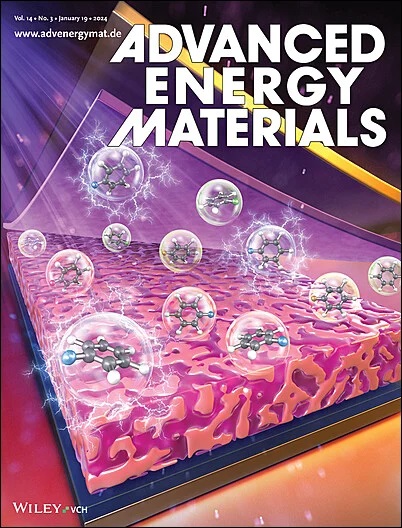Synergistic Reduction and Oxidation Resistant Interface Modifier for High-Voltage and High-Loading Solid-State Lithium Batteries
IF 24.4
1区 材料科学
Q1 CHEMISTRY, PHYSICAL
引用次数: 0
Abstract
Solid-state batteries (SSBs) with high-voltage cathodes and Li-anodes offer promising energy density and safety for next-generation batteries. However, poor contact and electrochemical instability of solid electrolyte interfaces hinder their long-term performance. Traditional rigid solidification interlayers possess restricted capability to address these issues. Herein, a composite buffer interlayer (CBI) with localized high-concentration electrolytes (LHCEs) in a flexible polymer scaffold, tackling contact and stability problems and ensuring a perfect interface is developed. The extended electrochemical window provides it with synergistic antioxidation and antireduction capabilities, making it compatible with high-voltage cathodes and Li anodes, while an in situ formed LiF-Li3N rich inorganic interface ensures uniform lithium deposition and prevents dendrite formation. This CBI enables lithium symmetric cells to achieve a super high critical current density of 7.2 mA cm−2. Most impressively, coupled with a high-voltage LiNi0.83Co0.12Mn0.05O2 cathode (NCM83), the full cell achieves 94.1% capacity retention after 125 cycles (coulombic efficiency >99.8%) at a mass loading of 14.6 mg cm−2 and a high voltage of 4.45 V. Additionally, a pouch cell with 17.2 mg cm−2 NCM83 achieves an initial discharge capacity of 3.82 mAh cm−2 an superior cycling stability (75 cycles, 89% capacity retention), showcasing the practical potential of LHCE-CBI enabled SSBs.

用于高电压和高负载固态锂电池的协同抗还原和抗氧化界面改性剂
本文章由计算机程序翻译,如有差异,请以英文原文为准。
求助全文
约1分钟内获得全文
求助全文
来源期刊

Advanced Energy Materials
CHEMISTRY, PHYSICAL-ENERGY & FUELS
CiteScore
41.90
自引率
4.00%
发文量
889
审稿时长
1.4 months
期刊介绍:
Established in 2011, Advanced Energy Materials is an international, interdisciplinary, English-language journal that focuses on materials used in energy harvesting, conversion, and storage. It is regarded as a top-quality journal alongside Advanced Materials, Advanced Functional Materials, and Small.
With a 2022 Impact Factor of 27.8, Advanced Energy Materials is considered a prime source for the best energy-related research. The journal covers a wide range of topics in energy-related research, including organic and inorganic photovoltaics, batteries and supercapacitors, fuel cells, hydrogen generation and storage, thermoelectrics, water splitting and photocatalysis, solar fuels and thermosolar power, magnetocalorics, and piezoelectronics.
The readership of Advanced Energy Materials includes materials scientists, chemists, physicists, and engineers in both academia and industry. The journal is indexed in various databases and collections, such as Advanced Technologies & Aerospace Database, FIZ Karlsruhe, INSPEC (IET), Science Citation Index Expanded, Technology Collection, and Web of Science, among others.
 求助内容:
求助内容: 应助结果提醒方式:
应助结果提醒方式:


